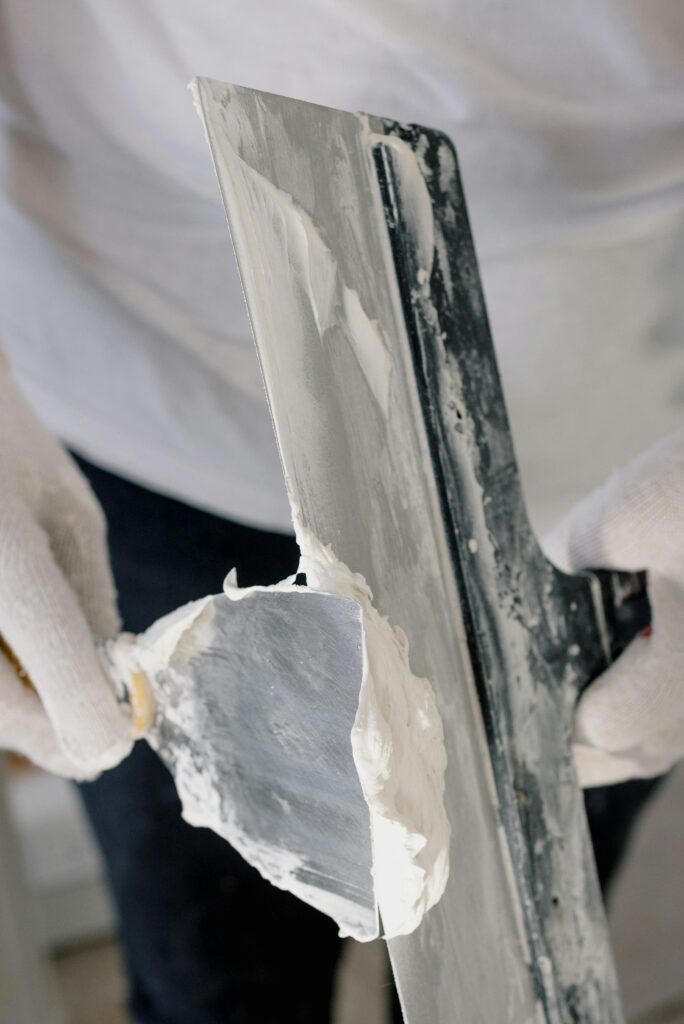Unlock the secrets of professional plastering as we reveal how your plastering trowel can transform ordinary walls into works of art.
In the world of professional plastering, achieving that perfect, glass-like finish isn’t just about skill – it’s about having the right tools and knowing how to use them. The plastering trowel, often considered the plasterer’s most vital implement, can make the difference between a mediocre job and a masterpiece. At Kent Plasterers, we’ve spent decades perfecting our craft, and we’re here to share our expertise on mastering this essential tool.
Understanding Your Plastering Trowel
A professional plastering trowel is more than just a simple hand tool – it’s a precisely engineered instrument designed for optimal performance. The heart of any quality trowel is its high-carbon steel blade, carefully tempered to provide the perfect balance of flexibility and durability. Modern trowels typically feature ergonomic handles with soft-grip technology, reducing fatigue during those long plastering sessions. The blade’s thickness and spring are crucial factors that influence the tool’s performance, with professional-grade trowels featuring precisely calculated measurements to ensure consistent results.
Types and Sizes of Plastering Trowels
- Standard Finishing Trowel: 14′ x 5′ – The most versatile option, perfect for general plastering work
- Large Finishing Trowel: 16′ x 5′ – Ideal for covering larger areas and achieving smoother finishes
- Extra-Large Trowel: 4.5′ x 18′ – Specialized tool for professional finishing on large wall surfaces
- Small Detail Trowel: 8′ x 3′ – Perfect for corners, edges, and detail work
- Pool Trowel: Curved blade for rounded surfaces and corners
Quality Matters: What Makes a Great Plastering Trowel
A superior plastering trowel combines several essential features that contribute to its performance and longevity. The blade should be made from hardened, tempered steel with a thickness of at least 0.8mm. The handle must provide excellent grip and control, typically featuring soft-touch materials and ergonomic design. Look for pre-worn edges that help prevent marking the plaster and finger protection features for improved handling. Recent studies show that professional-grade trowels can last up to 60% longer than budget alternatives when properly maintained.
Essential Trowel Techniques for Perfect Plastering
Mastering your plastering trowel requires understanding the fundamental techniques that deliver professional results. The key lies in maintaining consistent pressure and angle while working. Hold your trowel at approximately 20 degrees to the wall surface, applying even pressure throughout each stroke. The movement should be smooth and continuous, with each pass slightly overlapping the previous one. Professional plasterers typically work in sections of about 1 metre square, ensuring complete control over the finish.
The Art of Smooth Application
- Start from the bottom and work upwards for walls
- Maintain consistent pressure throughout each stroke
- Work in systematic patterns to ensure even coverage
- Keep your trowel clean between applications
- Adjust your angle based on the plaster’s consistency
Finishing Techniques for Professional Results
The final finish requires a delicate touch and precise technique. Once your base coat has firmed up but remains workable, use light, sweeping strokes with your trowel held almost flat against the surface. This technique, known as ‘closing up,’ creates that coveted smooth finish. For particularly challenging areas, mist the surface lightly with water using a spray bottle to help achieve the perfect finish.
Maintaining Your Plastering Trowel
A well-maintained trowel is essential for achieving consistent results. Regular maintenance can extend your trowel’s lifespan by up to 5 years. Clean your trowel thoroughly after each use, removing all plaster residue before it hardens. Use a wire brush for stubborn deposits, but be careful not to scratch the blade. Apply a light coat of oil to prevent rust, particularly if you’re storing the trowel for an extended period.
Cleaning and Storage Best Practices
- Clean immediately after use with warm water
- Use a dedicated trowel cleaning brush
- Dry thoroughly to prevent rust
- Store in a dry place, preferably hanging
- Apply rust preventative oil monthly
When to Replace Your Trowel
Even the best-maintained trowels eventually need replacement. Signs it’s time for a new trowel include: visible wear on the blade edge, rust spots that won’t clean off, blade warping, or handle damage. Most professional plasterers replace their main trowel every 2-3 years with heavy use.
Common Mistakes and How to Avoid Them
- Using too much pressure when finishing
- Working with a dirty or damaged trowel
- Neglecting proper maintenance
- Choosing the wrong size trowel for the job
- Not allowing sufficient drying time between coats
Achieving Professional Results: Final Tips and Tricks
Success in plastering comes down to attention to detail and proper technique. Keep your workspace clean and organized, maintain your tools meticulously, and always prepare surfaces properly before beginning. Remember that different plaster types may require slightly different techniques – always read manufacturer guidelines and test on a small area first. With practice and patience, combined with the right tools and techniques, you’ll be able to achieve those perfect, smooth finishes that define professional plastering work.
FAQ
What is the most common notched trowel?
U-Notched or Square-Notched Trowel These are the most commonly used trowels for tile installations. They have straight sides and either a square notch, or U-shaped notch. Square notches are typically used for smaller tiles, while U-notches are suitable for larger tiles.
Which direction should I trowel thinset?
This allows better air release when you bed the tile. Be careful not to leave any voids along chalk lines or between tiles trial size matters.
Are Marshalltown trowels worth it?
Customers find the trowel to be worth the money, with one customer noting it’s the best on the market. Customers have mixed opinions about the trowel’s quality, with some finding it reliable, while others describe it as a cheap Chinese copy.
Sources
[1] https://marshalltown.com/pro-3937-plastering-trowels
[2] https://goldblattusa.com/product/soft-grip-plaster-trowel/
[3] https://www.youtube.com/watch?v=0Xy5gd_G_Hw

